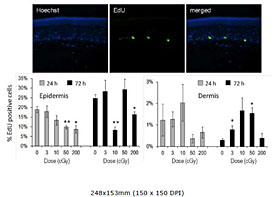- Number 364 |
- June 4, 2012
Targets of ionizing radiation identified in a human skin model

Experiments examine the effect of low doses
of ionizing radiation on proteins in human
skin cells.
Very low doses of ionizing radiation can change the structure and possibly the function of proteins that reside in human skin cells, according to scientists at DOE's Pacific Northwest National Laboratory. Low doses of ionizing radiation are often encountered, such as going into the hospital and receiving a full body CT scan. In addition to identifying proteins changed by the radiation, the team showed that the study’s reconstituted human skin system responds in a coordinated fashion to maintain tissue integrity and mitigate exposure effects.
Using resources in DOE's EMSL to identify proteins affected by radiation exposure, the scientists found 1052 protein modifications in the skin model. These modifications involve adding or removing a phosphate group on proteins, a critical change that alters protein function, enabling cells to rapidly respond to the environment. The team found that 176 of the 1052 unique phosphopeptides were altered when exposed to low doses of radiation. While just a subset of the total molecular alterations that occur after exposure, "This data can be used to assess proteins and molecular pathways affected by radiation," said PNNL biophysicist Dr. David Stenoien.
While some of the identified proteins have roles previously reported in radiation responses, using a fully differentiated skin model enabled identification of many novel radiation responsive proteins. Prominent among these is profilaggrin, a protein important for maintaining the skin's ability to block outside intruders such as bacteria from entering the body. It also helps keep the skin hydrated. This protein acquired phosphate groups or was phosphorylated, when it received low levels of radiation. To the PNNL team's knowledge, their study provides the first description of the areas where proteins in the human skin are phosphorylated and the study shows how these changes can impact the natural lifecycle of profilaggrin.
While the effects of high doses of radiation are well documented, the health consequences of low doses are still being debated. Because humans are exposed continuously to low doses of ionizing radiation from the environment, medical procedures, and in certain occupations, it is important that any health consequences are thoroughly understood.
The work was funded by DOE's Office of Biological and Environmental Research's Low Dose Radiation Research Program and the Defense Threat Reduction Agency.
[Kristin Manke, 509.372.6011,
kristin.manke@pnnl.gov]
